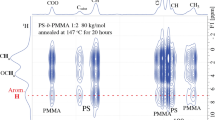Abstract
Pulsed deuteron NMR line shapes have been analysed to characterize type and time scale of the phenylene group motion in glassy bisphenol-A polycarbonate. The motional mechanism involvesπ-flips about theC 1 C 4 axis augmented by small angle fulctuations about the same axis, reaching a rms amplitude of ±35‡ at 380 K. The distribution of correlation times for theπ-flips is heterogeneous in nature and can be described either by a log-Gaussian or an asymmetric distribution with a more rapid decay at high correlation times comparable to the Williams-Watts distribution. From both distributions essentailly the same mean activation energy of 37 kJ/mol is obtained, whereas the temperature dependent width of the highly asymmetric distribution is somewhat smaller compared to the log-Gaussian distribution. Time scale and activation energy of theπ-flip motion are correlated to secondary mechanical relaxations. Low molecular mass additives, which suppress the mechanical relaxation, also hinder the phenylene motion for a substantial fraction of phenylene groups. The effect of additives is not only to shift the mean value of the distribution of correlation times to higher values but also to increase drastically the width of the distribution. The results of this work strongly suggest that the secondary mechanical relaxation and the large amplitude motions of the phenylene groups in polycarbonate are related.
Similar content being viewed by others
References
Locati G, Tobolsky AV (1970) Advan Mol Relax Proc 1:375
Heijboer J (1977) Intern J Polym Mat 6:11
Spiess HW (1983) Coll & Polym Sci 261:193
Spiess HW (1985) Advan Polym Sci 66:23
Schmidt C, Kuhn HJ, Spiess HW (1985) Progr Coll & Polym Sci 71:71
Schaefer J, Stejskal EO, Steger TR, Sefcik MD, McKay RA (1980) Macromolecules 13:1121
Fischer EW, Hellmann GP, Spiess HW, Hörth FJ, Ecarius U, Wehrle M (1985) Macromol Chem Suppl 12:189
Schnell H (ed) (1964) Chemistry of Polycarbonates, Polym Rev 9, Interscience Publishers, New York, pp 31–40
Kuhn KJ (1981) Diploma thesis, University of Mainz
Hentschel R, Spiess HW (1979) J Magn Resonance 35:157
Inglefield PT, Amici RM, O'Gara JF, Hung C-C, Jones AA (1983) Macromolecules 16:1552
Schaefer J, Stejskal EO, McKay RA, Dixon WT (1984) Macromolecules 17:1479
Williams G, Watts DC (1970) Trans Faraday Soc 66:80
Lindsey CP, Patterson GD (1980) J Chem Phys 73:3348
Roy AK, Jones AA, Inglefield PT (1986) Macromolcules 19:1356
Wehrle M (1986) Dissertation, University of Mainz
Author information
Authors and Affiliations
Rights and permissions
About this article
Cite this article
Wehrle, M., Hellmann, G.P. & Spiess, H.W. Phenylene motion in polycarbonate and polycarbonate/additive mixtures. Colloid & Polymer Sci 265, 815–822 (1987). https://doi.org/10.1007/BF01418458
Received:
Accepted:
Issue Date:
DOI: https://doi.org/10.1007/BF01418458




